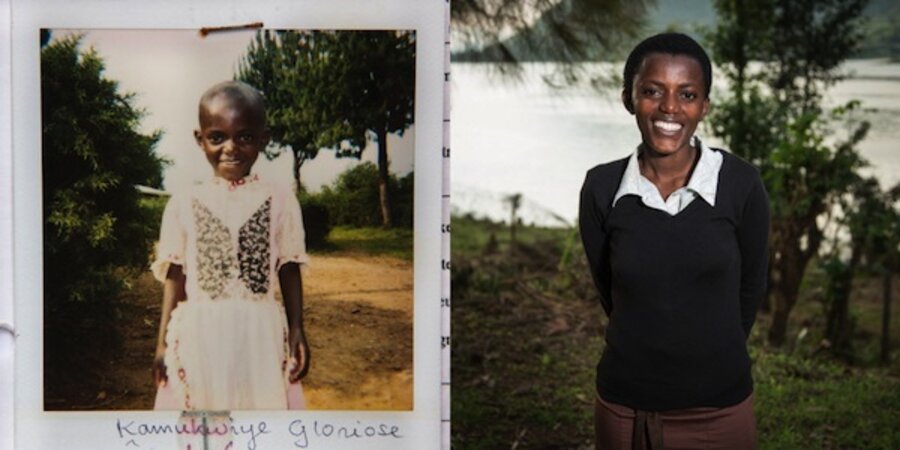From a forgotten photo archive, Rwanda's orphans reclaim their history
Loading...
| Nairobi, Kenya
Last December, the staff of the British charity Save the Children discovered ten gray metal crates sitting in an old shipping container in the Rwandan capital Kigali.
Inside was a historical treasure trove. Packed in hundreds of green manila folders were handwritten files documenting the experiences of thousands of children whose parents died in Rwanda's 1994 genocide, when Hutu extremists slaughtered over 800,000 Tutsis and moderate Hutus in 100 days.
Each of the roughly 8,000 files contained the story of an orphaned child and a Polaroid photograph. Save the Children tracing teams created the files to help them to unite children with surviving relatives and, in the years after the genocide, traveled around Rwanda to search for adults who might recognize the children and take them in.
As Rwandans this month mark the genocide's 20th anniversary, the newly unearthed files offer an invaluable archive of one of the darkest episodes of modern history. Save the Children decided to use the archive to track down some of the children who are now adults to show them their picture and to see what had become of them.
Chasing false leads
The task of sifting through all the pictures fell to Colin Crowley, a Save the Children photographer from Beloit, Wis., who lives in Nairobi.
“I spent hours and hours just looking through it,” Crowley recalls. “Any one story you can pick up and read and nearly be brought to tears. You have these eyes staring back at you, you can get this full picture of this unthinkable tragedy that happened to one kid, and you get lost in it. And then you put it down and look up, and there’s 8,000 more in front of you.”
Tracking down the children was more difficult than he expected. For a week Crowley and his colleagues chased false leads around the country. Then, leafing through the files one afternoon, he found the photos of three children, apparently siblings, that moved him.
The two oldest, Flodouard, 16, and Cyprien, 12, bore stern expressions in their pictures, but in hers the youngest, a six-year-old girl in a frilled dress named Gloriose, had a big smile. Crowley pieced together that the older two siblings had shielded their younger sister from their parents’ murder.
“Right away I knew there was a story there,” Crowley says. “I was like, ‘I think we can find these people.’”
Crowley drove out to the village where the three had been resettled, and tracked down Flodouard’s small farm. In contrast to the grim-faced boy in the picture, they found a smiling and proud father who appeared to have overcome the horror of his childhood.
He laughed loudly upon seeing his picture, exclaiming about the T-shirt he was wearing, which at the time must have been one of his few possessions.
Adopted by uncle
“When the massacres were happening, I was there but I hid myself underneath the corpses,” he recounted to Crowley. “It was as if God himself was hiding me, but I saw everything that happened.”
When the killings abated, he took his three siblings – besides Cyprien and Gloriose there was a two-year-old girl who died days later – and made their way to a makeshift orphanage. A tracing team found them there, and eventually placed them with an uncle.
But their journey didn’t end. The uncle had adopted a slew of orphans, and life was hard. Though still a teenager, Flodouard decided to quit school, move back to farm on his parents’ land and support his siblings' studies. His younger brother graduated from secondary school and joined the military.
As for Gloriose, she is studying crop science at the University of Rwanda in Busogo, which is where Crowley found her. Today she is a composed 25-year-old college student, a far cry from the smiling but clearly malnourished girl in the Polaroid.
Crowley showed her the picture in her dorm room surrounded by her girlfriends. She couldn’t stop smiling upon seeing herself, but there was sadness too. Her first reaction was to speak of the recent death of her uncle, who initially took them in.
“I felt like I was going to cry,” she told Crowley. "I think when this photo was taken I still believed that everything was going to be okay and that my parents were still alive and that they would provide me with a happy life.”
Though Crowley was worried the pictures would dredge up bad memories, the siblings told him they had helped them make sense of their remarkable journeys.
“It reminded right away of my past,” said Cyprien, now 33. “I could see myself when I was young and remember everything I’ve been through. It makes me think that history is never erased.”
Giving back history
None of the three siblings had seen photos of themselves as children. Gloriose at first didn’t even recognize herself, says Crowley. Before leaving the siblings, he gave each a copy of their file, a larger photo-quality print of their Polaroid, and a new Polaroid taken that day.
Save the Children is looking to digitize the entire 8,000-file archive so that more Rwandan orphans can connect with their past.
“This project started out about us trying to tell this story [about what happened to orphans after twenty years],” Crowley says. “But what I realized was actually what we were doing was giving people this piece of their history back.”







